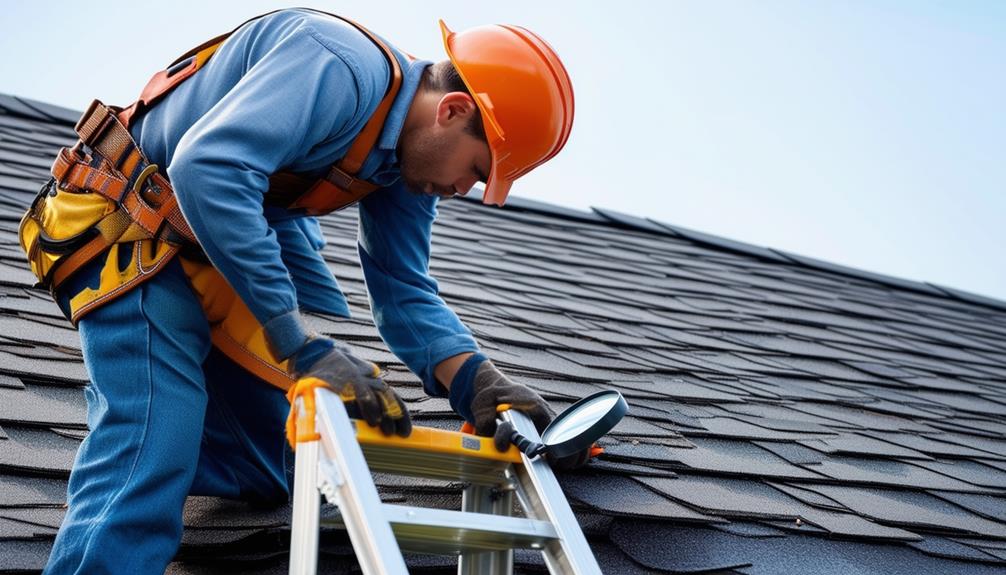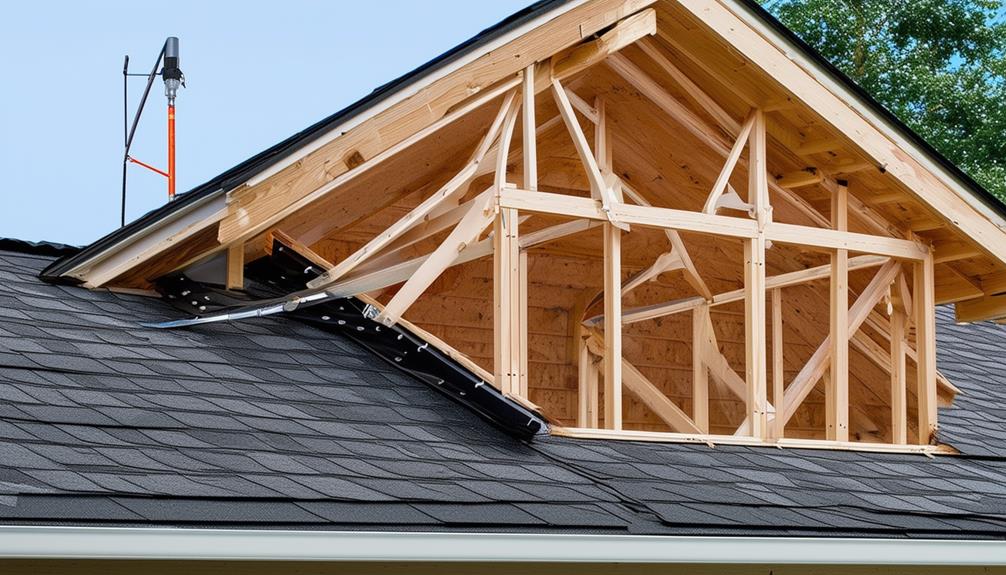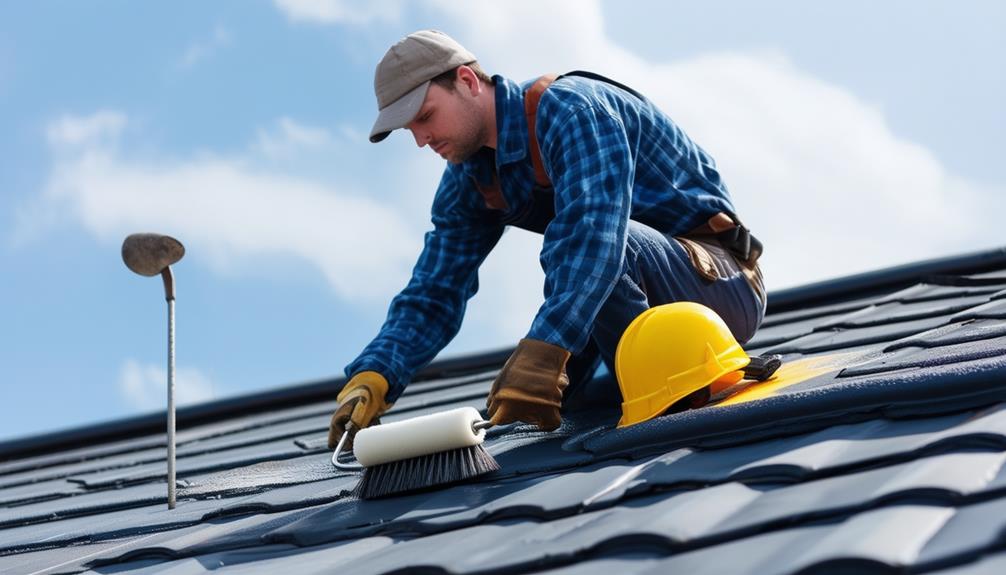Fortify your roof's resilience in extreme weather by prioritizing key maintenance tasks. Start with regular roof inspections to catch issues early. Secure loose shingles and flashing promptly to prevent water damage. Strengthen roof structures by reinforcing support elements. Keep gutters clear of debris to avoid backups and damage. Consider applying weather-resistant coatings for enhanced protection. By following these steps, you'll fortify your roof against severe conditions and ensure its longevity.
Importance of Roof Inspection

Regular roof inspections are crucial for identifying potential issues before they escalate into costly repairs or damages. Proper roof maintenance is key to guaranteeing the longevity and functionality of your roofing system. By scheduling a professional inspection at least once a year, you can catch small problems early on and prevent them from turning into major concerns.
During a professional roof inspection, trained experts will thoroughly assess the condition of your roof, checking for signs of wear and tear, damage, or areas of weakness. They will also inspect the flashing, gutters, and overall structure to make sure everything is in good working order. Professional inspectors have the knowledge and expertise to detect issues that may go unnoticed by the untrained eye.
Investing in regular roof maintenance and professional inspections can save you a significant amount of money in the long run by addressing minor problems before they escalate into major repairs. It is a proactive approach that can help you avoid costly damage and ensure the safety and security of your home.
Securing Loose Shingles and Flashing
Inspecting your roof for loose shingles and flashing is vital to maintaining the structural integrity and weatherproofing of your home. Secure any loose shingles promptly to prevent water infiltration and potential damage to the underlying roof structure. Use a high-quality sealant to adhere the shingles back in place securely. Additionally, check the flashing around chimneys, vents, and skylights as they are common areas for leaks to develop. Make sure the flashing is tightly sealed and free of any cracks or gaps where water could seep through.
Regular roof maintenance plays an essential role in leak prevention and waterproofing techniques. By addressing loose shingles and flashing promptly, you can avoid costly repairs and potential water damage to your home's interior. Take the time to inspect your roof at least twice a year, especially after severe weather conditions. Investing in proper maintenance and sealant application will help extend the lifespan of your roof and protect your home from extreme weather elements.
Reinforcing Roof Structures

Ensure the structural integrity of your roof by reinforcing key support elements to withstand extreme weather conditions. Roof reinforcements are essential in ensuring your roof can withstand the harshest of weather. Start by inspecting the trusses and rafters for any signs of damage or weakness. Reinforce these elements by adding additional bracing or supports where needed. Weatherproofing measures such as sealing roof joints and connections can also help in maintaining the overall structural integrity of your roof.
Regular maintenance is key to preventing any potential issues. Make sure to inspect the roof structure at least once a year, and after any severe weather events. Look for signs of sagging, cracks, or water damage, and address them promptly. Additionally, consider consulting a professional roofer for a thorough inspection and to perform any necessary reinforcements or repairs. By taking these maintenance tips and weatherproofing measures seriously, you can greatly enhance the durability and longevity of your roof.
Clearing Debris and Gutters
To ensure your roof is ready for extreme weather, one essential step is clearing debris and maintaining clean gutters. Proper gutter maintenance and debris removal are vital aspects of roof protection and storm preparation. Clogged gutters can lead to water backup, causing damage to your roof and home interior during heavy rains or storms. Leaves, branches, dirt, and other debris should be cleared regularly to make certain that water can flow freely off the roof and away from the structure.
Inspect your gutters at least twice a year, especially before the rainy season or winter. Remove any accumulated debris by hand or with a trowel, and flush the gutters and downspouts with water to check for proper drainage. Consider installing gutter guards to prevent debris buildup and minimize the need for frequent cleaning. Keeping your gutters clean and free of obstructions is a simple yet effective way to enhance the longevity and resilience of your roof against extreme weather conditions.
Applying Weather-Resistant Coatings

Applying weather-resistant coatings to your roof is an essential measure that enhances its durability and protection against harsh weather conditions. These coatings offer a range of benefits including increased resistance to UV rays, water damage, and mold growth. By creating a barrier between your roof and the elements, weather-resistant coatings can greatly extend the lifespan of your roof.
When applying weather-resistant coatings, it is vital to follow proper application techniques to guarantee maximum effectiveness. Thoroughly clean the roof surface before application to remove any dirt or debris that could hinder adhesion. Apply the coating evenly and according to the manufacturer's instructions to ensure top performance.
Investing in weather-resistant coatings for your roof can lead to long-term durability and reduced maintenance costs. The initial cost of applying these coatings is outweighed by the savings achieved from preventing damage and the need for frequent repairs. By safeguarding your roof with weather-resistant coatings, you are protecting your home from the unpredictable forces of nature.
Frequently Asked Questions
Can Extreme Weather Cause Damage to the Roof's Underlayment?
Extreme weather can indeed cause damage to the roof's underlayment. Proper underlayment protection and maintenance are essential to safeguard your roof. Choosing high-quality roofing materials known for their durability can also help mitigate potential damage. Regular inspections and repairs can guarantee your roof is prepared to withstand the harshest weather conditions. Be proactive in maintaining your roof to prevent costly damage and secure its longevity.
How Can I Prevent Ice Dams From Forming on My Roof?
To prevent ice dams on your roof, focus on enhancing roof insulation and maintaining gutters. Installing heat cables can help melt snow, while proper roof ventilation aids in regulating temperatures. By combining these techniques, you can minimize the risk of ice dams forming and causing potential damage to your roof. Regular upkeep and strategic measures can safeguard your roof against extreme weather conditions.
Are There Specific Types of Vegetation That Can Harm My Roof?
Tree branches hanging over your roof can cause damage by scraping against shingles, leading to potential leaks. Moss and algae growth on your roof can also be harmful, causing discoloration and potentially weakening the roofing materials over time. Regularly trimming tree branches and keeping your roof clean from moss and algae can help prevent these issues and prolong the life of your roof.
Should I Consider Installing Lightning Protection for My Roof?
Considering installing lightning protection for your roof is an essential decision. It acts as a shield, guarding your roof against the wrath of lightning strikes. This added layer of roofing safety is vital in preventing storm damage and maintaining the integrity of your roof. By investing in lightning protection, you are taking a proactive step towards safeguarding your home and ensuring its longevity amidst extreme weather conditions.
What Are the Signs of Hail Damage on a Roof?
Inspect your roof after a hailstorm for signs of damage like missing granules, dents, or cracks in shingles. If you notice any issues, it's important to repair them promptly to prevent further damage. Check your insurance policy for coverage on hail damage; you may need to file a claim. A thorough roof inspection is essential to identify and address any hail damage efficiently. Regular maintenance and quick repairs can help safeguard your roof from future weather-related issues.
Conclusion
Make sure to take the necessary steps to prepare your roof for extreme weather conditions. By inspecting, securing, reinforcing, clearing, and applying weather-resistant coatings, you can help protect your home from potential damage. Don't wait until it's too late – be proactive and guarantee your roof is ready to withstand whatever Mother Nature may throw its way. Your efforts now can save you time, money, and stress in the long run. Understanding how weather impacts your roof is crucial for maintaining its durability and extending its lifespan. Harsh conditions like heavy rain, strong winds, or freezing temperatures can weaken its structure over time, leading to costly repairs if left unaddressed. Regular maintenance and early intervention can ensure your roof remains a strong line of defense for your home, no matter the season.




